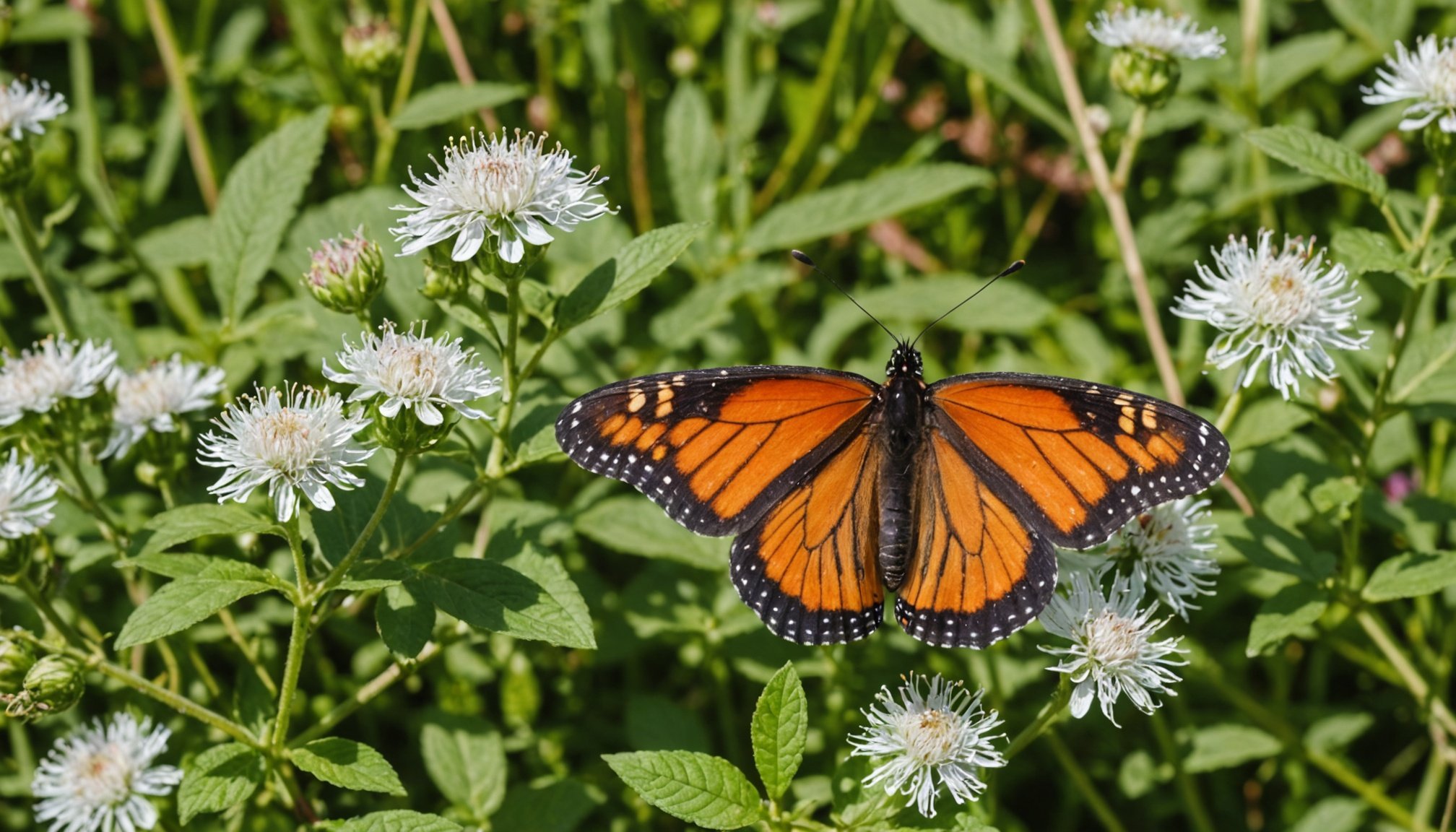Introduction to Butterfly Habitat in UK Gardens
Creating butterfly habitats in UK gardens is vital for boosting biodiversity. Native butterflies rely heavily on cultivated spaces, as their natural habitats continue to decline. Gardens serve as mini wildernesses, playing a significant role in supporting local ecosystems. There are several butterfly species endemic to the UK, such as the Peacock and the Painted Lady, that could thrive with proper habitat creation.
Butterflies are pivotal pollinators, and encouraging their presence in gardens contributes to a flourishing ecosystem. By planting butterfly-friendly gardens, individuals can directly influence the health and sustainability of local biodiversity. Gardens offer essential resources including food, shelter, and breeding sites, thus forming an integral part of the ecological network.
Also to discover : Preserving Wildlife Journeys: The Role of UK Overpasses and Underpasses in Protecting Migratory Species
Furthermore, sustainable gardening practices empower individuals to contribute consciously to conservation efforts. Using native plants, gardeners can help alleviate the pressures on butterfly populations, providing them with the necessary environments to thrive. Consequently, UK gardens can transform into sanctuaries for conserving butterfly species and supporting the broader goal of biodiversity enhancement.
Essential Plant Species for UK Gardens
Choosing the right mixtures of native plants plays a critical role in fostering vibrant butterfly habitats. These species support the entire butterfly lifecycle, from larvae to adulthood, benefiting their growth and survival.
In the same genre : Empower UK Citizens: Transform Your Community with Local Bat Conservation Efforts
List of Must-Have Plant Species
In UK gardens, incorporating butterfly-friendly plants like Buddleia, commonly known as the Butterfly Bush, is vital. It offers abundant nectar, attracting various butterfly species. Similarly, Lavender provides not only nectar but also a habitat that’s essential for numerous insects.
Characteristics of Supportive Plants
Butterflies thrive on plants that meet their life cycle requirements. Flowers with plentiful nectar cater to adult butterflies, while host plants are indispensable for caterpillars. For instance, Nettles serve as host plants for the Peacock and the Red Admiral butterflies.
Plants for Various Garden Conditions
The creation of diverse conditions ensures optimal butterfly support. For sunny environments, options like Verbena and Echinacea are effective. Meanwhile, shaded areas can benefit from ferns and wild violets. Cultivating a mix of plant species suitable for different conditions maximises the attraction and sustenance of butterflies, thereby enriching biodiversity. Choosing wisely creates a supportive environment for these captivating creatures, turning gardens into resilient ecosystems.
Benefits of Specific Plants for Butterflies
Selecting specific plants is crucial for creating a sanctuary for butterflies, maximising garden biodiversity.
Nectar Producing Plants
Nectar sources are essential for butterflies’ survival, offering food and energy. Diverse flower sources attract multiple species, ensuring continuous nectar supply. Plants like Verbena and Buddleia bloom across different seasons, providing consistent nourishment.
Host Plants for Caterpillars
Caterpillar hosts are indispensable, nurturing the early stages of butterfly development. Each butterfly species has preferences for certain plants. For example, Nettles are preferred by Peacock and Red Admiral caterpillars. Integrating an array of host plants fosters a healthy lifecycle for butterflies.
Plants for Shelter and Nesting
Creating shelter with layered planting provides critical protection. Grasses and shrubs buffer against weather, enhancing safety. Plants like Lavender act as natural nests, safeguarding the delicate stages of butterfly development. Thoughtful design incorporating staggered heights and densities fortifies these essential habitats.
These tailored plant selections not only beautify gardens but underpin ecological resilience and biotic interactions, forming robust nodes within local ecosystems. Empower your garden with nectar, host, and shelter plants to sustain butterfly populations year-round.
Planting and Maintenance Tips for Butterfly Gardens
Creating a thriving butterfly habitat in UK gardens involves thoughtful planting tips and garden maintenance practices. Initially, select a variety of native plants that cater to different butterfly life stages. Ensure diverse species to provide both nectar for adults and host plants for caterpillars.
Use pesticide-free gardening methods to protect butterflies and other beneficial insects. Chemical treatments can harm butterflies or disrupt their complex life cycles. Opt for organic solutions like companion planting to manage pests naturally. Keep in mind that healthy butterflies often indicate a well-balanced ecosystem.
Seasonal maintenance activities keep gardens in peak condition year-round. Regularly deadhead flowers to encourage more blooms, ensuring a continuous nectar supply. Pruning shrubs annually helps maintain shelter structures vital for nesting and protection from harsh weather. Clean up garden debris in autumn to ready the space for new growth in spring, balancing tidiness with areas of shelter for overwintering species.
Ultimately, dedication to these practices enhances the garden’s role in promoting biodiversity. By considering butterfly needs and sustainability, gardeners cultivate vibrant landscapes where local ecosystems flourish. Enthusiasts contribute meaningfully to conservation by maintaining spaces where butterflies can thrive and enchant.
Enhancing Local Ecosystems Through Gardening
Gardening plays a vital role in supporting local ecosystems, transforming urban spaces into biodiversity-rich environments. By integrating native plants, gardeners can actively contribute to biodiversity conservation efforts. Native plants not only support local wildlife but also require fewer resources to maintain, aligning perfectly with sustainable practices. They have evolved to thrive in local soil and climate conditions, making them resilient and effective in supporting various species, especially native butterflies.
Incorporating conservation gardening methods such as using butterfly-friendly plants directly aids in creating vibrant habitats. These gardens act as ecological corridors, connecting fragmented habitats and allowing species to move safely in urban landscapes. As a result, they encourage population diversity and reduce the risks of genetic isolation.
Successful case studies of butterfly gardens across the UK illustrate the transformative impact these gardens can have. For instance, community-led initiatives in towns like Brighton have shown significant increases in butterfly sightings and diversity, showcasing the potential of small-scale actions. By embracing these practices, even individual gardeners can make meaningful contributions to conservation, fostering ecosystems that support a wide array of wildlife and enriching urban biodiversity.
Visual Resources and Further Reading
Gardening enthusiasts seeking to enrich their understanding of butterfly identification will find visual guides invaluable. These resources offer detailed illustrations and information on different plant and butterfly species, aiding both novices and seasoned gardeners in recognising and understanding the dynamics of their garden habitats.
Recommended Books and Websites
Several books cater to butterfly gardening enthusiasts, providing comprehensive insights into the cultivation of butterfly-friendly gardens. Accompanying these are online resources that offer timely updates and interactive content. By consulting these guides, gardeners can make informed decisions on plant species and garden layouts that benefit both butterflies and biodiversity.
Community Resources and Organizations
Engaging with local organizations committed to butterfly conservation offers vital support. These groups often provide resources and educational programs to aid gardeners in nurturing and protecting local ecosystems. Participation in workshops or events can amplify gardening efforts, fostering a shared commitment to ecological wellbeing.
Visual identification guides and community organizations empower gardeners, equipping them with both knowledge and support to sustain vibrant gardens. Through these resources, individuals not only enhance the beauty of their gardens but also contribute significantly to preserving biodiversity and aiding in wildlife conservation.






